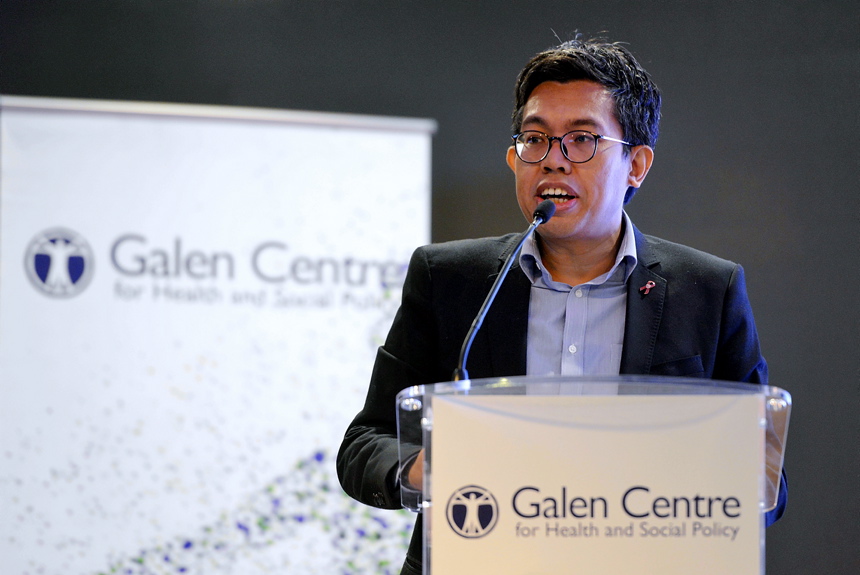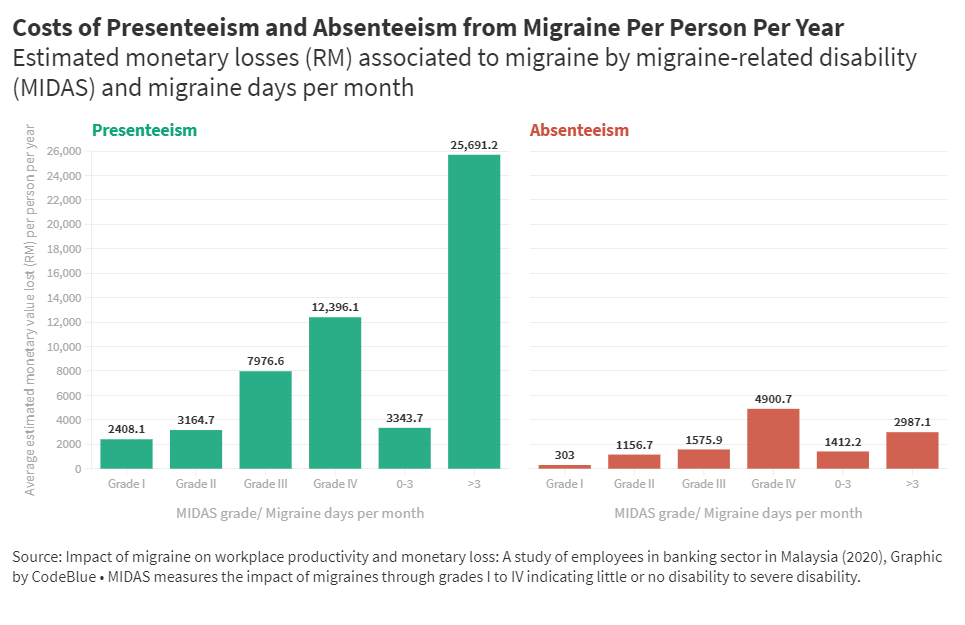KUALA LUMPUR, Dec 22 — Monetary loss from migraine sufferers who work with reduced productivity while sick is more than triple the financial costs of absenteeism, a Malaysian study revealed.
The study by Wong et al published this year in The Journal of Headache and Pain, which examined the impact of migraine on workplace productivity and monetary loss among employees in the banking sector in Malaysia, found that the average monetary loss from presenteeism was RM5,392.60 per employee annually, 3.5 times higher than absenteeism at RM1,548.30.
Monetary loss from presenteeism increased with the severity of migraine, from RM2,408.10 per person per year for MIDAS grade I, to RM12,396.10 for MIDAS grade IV. MIDAS is the Migraine Disability Assessment that measures the impact of migraines and allows for determination of pain intensity and disability level, through grades I to IV indicating little or no disability to severe disability.
Patients with grade I or grade II migraine, less severe conditions, typically require only over-the-counter analgesics to reduce migraine disability, while grade III or grade IV require migraine-specific treatments.
According to the 2020 study on Malaysia’s banking sector, the estimated monetary loss from presenteeism shot up to a high of RM25,691.20 per person per year for migraine sufferers with more than three migraine days a month, nearly eight times higher than participants with three or fewer days of migraine monthly at RM3,343.70. Close to 10 per cent of study participants experienced more than three migraine days a month.
The estimated financial costs due to absenteeism from migraine were much lower than presenteeism, from RM303 for MIDAS grade I per person per year, to RM4,900.70 for MIDAS grade IV. Monetary loss from absenteeism reached RM2,987.10 for migraine sufferers with over three days of migraine a month, twice as high as those with three or fewer migraine days monthly at RM1,412.20.
The study found that the mean per cent productivity loss at work, also known as presenteeism, was almost 20-fold higher than the mean per cent work time missed due to migraine (absenteeism), at 39.1 per cent versus 1.9 per cent.
Researchers warned employers and employees that working while sick not only caused productivity loss, but also worsened one’s existing medical condition and can lead to poor health and exhaustion.
Authors cited various reported reasons for sickness presenteeism, such as economic considerations, job insecurity, high workload, inability of others to take over duties, and inability to adjust to work demand.
Researchers noted that the “remarkably higher” average monetary loss due to presenteeism among individuals with MIDAS grade IV at about RM12,400 per year, as well as in people with over three migraine days per month at nearly RM26,000 annually “provide insights into the high burden of presenteeism to organisations and underscore the importance of policies to manage presenteeism.”
Although the overall percentage of absenteeism in the study was found to be near 2 per cent, migraineurs with MIDAS grade IV were found to have a two-fold higher percentage of absenteeism than overall migraineurs. Likewise, participants with more than three days of migraine per month had a 1.5 times higher rate of absenteeism than those with three or fewer migraine days.
Most Migraine Sufferers Don’t Seek Medical Treatment

The study observed that almost two-thirds of migraine sufferers with low disability did not obtain medical care, while a small proportion with high disability and headache frequency did not seek treatment but only used over-the-counter medicines.
Just 30 per cent of migraineurs with severe disability from migraine, or MIDAS grade IV, reported taking prescribed medication, while 96 per cent of migraineurs who experienced three or fewer episodes of migraine a month did not seek treatment.
Although almost half of the study participants who had screened positive for migraine reported getting a diagnosis from a doctor, findings implied that another half of migraineurs did not recognise their illness as a health condition needing treatment. People with migraine can seek specialist treatment from neurologists.
“The present study importantly highlights the unmet needs in migraine management among employees at [the] workplace. It appeared that a vast majority of migraine sufferers do not seek medical care for pain relief and only resorted to over-the-counter pain medicines,” said researchers.
Prevalence of migraine, according to the study, peaked at one’s prime working age from 31 to 40 years. Women reported higher prevalence of migraine than men, as the study’s researchers called for a gender-based approach to promoting workplace migraine risk prevention and care.
“High rates of migraine during the time when career and family responsibilities are typically most crucial implies that migraines not only pose immense economic burdens on employers, but also substantially impact the harmony in a person’s social and family life.”
The 2020 study by Wong et al conducted an online survey among employees in two multinational banks in Malaysia between April and July 2019, with 47.2 per cent (598 participants) screening positive for migraine out of 1,268 employees who submitted complete responses. The percentage of participants with MIDAS grade I represented the majority of people diagnosed with migraine, while 36 per cent of participants reported MIDAS grade III and IV.
Migraine Handbook For Employers

The Galen Centre for Health and Social Policy has released a migraine handbook for employers. According to the health think tank, about 3.9 million individuals, or 12 per cent of the Malaysian population, live with migraine.
Migraine, said the Galen Centre, is not just a headache, but a medical condition that comprises four phases, with headache pain only consisting of one of these phases. The phases of migraine comprise premonitory (with symptoms like light and sound sensitivity), aura (with visual disturbance symptoms like flashing and blind spots), headache (with symptoms like throbbing pain and nausea and vomiting), and postdrome (with symptoms like feeling ‘hungover’, lack of comprehension, and fatigue).
Migraine headaches typically last between four and 72 hours.
“The complex nature of migraine means that the treatments available are varied and differ from person to person. Though there is currently no cure for migraine, there is effective treatment,” said the Galen Centre.
As migraine is under-diagnosed, the health think tank urged people with migraine to seek diagnosis and appropriate treatment, such as from neurologists. Galen Centre chief executive Azrul Mohd Khalib also suggested that employers cover migraine treatment for their employees.
The think tank recommended several reasonable accommodations related to the work environment or work practices that can enable an employee to do their job despite having a disability.
- Consider flexible hours and deliverable-based performance if the job doesn’t require an employee to be physically present at the office at certain times.
- Work-from-home option.
- Provide clean drinking water to ensure employees remain hydrated.
- Create a migraine-friendly break room for migraine sufferers who may find relief in a dark and quiet room.
- Provide time-off for employees to go for medical appointments.
- Ensure that desks, chairs, and computers at work stations are positioned at the right height and clearance.
- Manage lighting and glare. Direct or indirect glare can be managed by introducing shades, blinds, or filters.
- Increase ventilation and improve airflow in the workplace.
- Introduce stress management training for supervisors and employees to identify and manage stress factors in the workplace.
- Consult occupational safety and health professionals, like neurologists, on how to develop and maintain migraine-friendly workplaces.
“Implementing these steps has the potential to improve productivity, lower turnover, and lead to happier employees.”
The Galen Centre also provided a migraine action plan template for employees with migraine to guide discussions on the kind of support or assistance they need.
“Understandably, informing employers is not an easy thing to do and may be intimidating. However, doing so allows for management an opportunity to better understand how it affects the employee and introduce supportive changes,” the Galen Centre said.
As for employers, the think tank said an employee with migraine can request for a discussion with human resource or occupational health staff to work out solutions.
Note:
Estimated monetary value due to presenteeism per year (proportion of productivity loss exchanged for monetary value due to presenteeism) was calculated as individual payroll per person per hour in ringgit, multiplied by eight (working hours per day), multiplied by proportion of productivity loss, multiplied by days with condition per three months, multiplied by four (for changing into the costs per year).
Estimated monetary value due to absenteeism per year was calculated as individual payroll per person per hour in ringgit, multiplied by eight (working hours per day), multiplied by days of work missed due to migraine in the past three months, multiplied by four (for changing into the costs per year).









